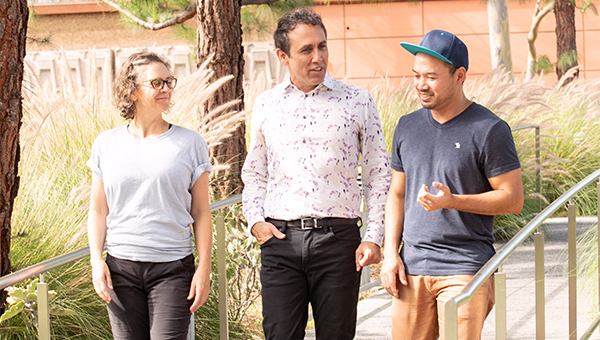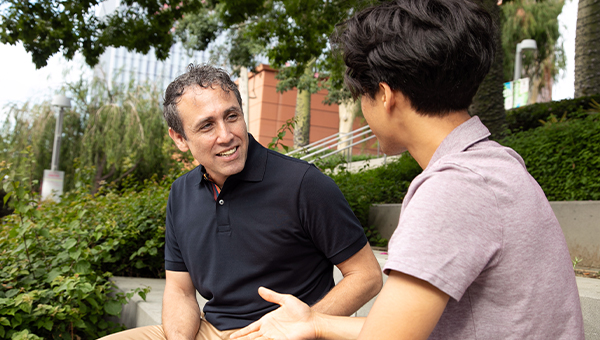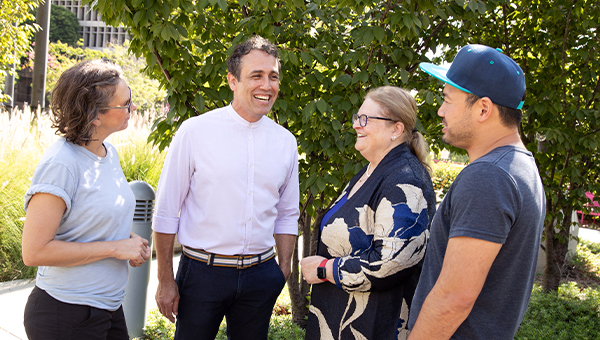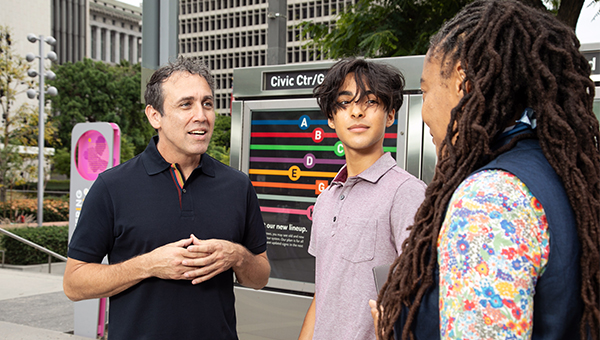From Infantry to Civic Arts Leader: Samir Bitar’s Journey to Transforming Los Angeles
By Jennifer Monahan
We spent some time with Bitar to find out what led to this next iteration in his journey and how he hopes to contribute to the Los Angeles City Council if elected.
This interview has been edited for length and clarity.
Heinz College: Tell us about the community that you hope to serve, if elected to represent District 14 on the Los Angeles City Council?
Samir Bitar: Geographically, it runs from Eagle Rock through El Sereno and Boyle Heights into Downtown, Skid Row, Little Tokyo, and the Arts District. It includes a diverse set of lifestyles, environments, neighborhood histories, and needs.
We need to do some work on the economy for these areas. For example, Downtown’s Historic Broadway Theater District is one of LA’s gems—not only is LA one of the creative capitals of the world, we have the highest density of historic theaters in the country—13 along Broadway alone. Yet the district is still designated as an underutilized business zone. There is enormous community support from a broad spectrum of stakeholders for the revitalization of this theater district. But efforts stalled during the pandemic, and current leadership has done nothing to kickstart this economic engine. This is just one of the many corridors within CD14 that need to be revitalized to attract jobs and improve quality of life.
Meeting His Constituents
"You have to get out into the community and ask questions and actually listen, particularly to the voices of people who have rarely been invited into the conversation," said Samir Bitar.
HC: In your platform, you talk about your passion for using the arts to make communities better and to heal the city. How do you envision leveraging the arts to address social issues and create positive change in Los Angeles?
SB: This is personal for me. I grew up poor and with a lot of trauma. Art saved my life.
I went into the army, and then was the first in the family to go to college. That’s where I found art—specifically dance. It wasn't until later that I started seeing all this research about art being used as therapy. I look around the streets where I live and talk to people who are homeless or struggling with mental illness, or have family members in prison. There’s evidence to show that art therapy could help. Rhodessa Jones is a brilliant woman who goes into women's prisons in California and uses dance to heal and educate. No one on City Council is talking about these types of solutions, and we should be.
Similarly, art and culture play a powerful role in civil discourse in a democratic society. We need to support our cultural institutions because of the role they play in fostering conversations of important topics in a safe, non-confrontational kind of way. In today’s politically polarized America, museums are some of the few public spaces remaining where we can convene critical conversations of our time; they’re spaces where we can engage in civil, democratic discourse—because they draw a broad cross-section of Americans.
HC: Your journey from being an Infantry Soldier in the U.S. Army, to your years at the Smithsonian, to your current role as a candidate for Los Angeles City Council is remarkable. How have those broadly varied experiences influenced your approach to public service?
SB: The through line is integrity. The oldest son in every generation of my family that I’m aware of served in the army, so that’s what I did. I’m very proud of my military service, which is one kind of public service. However, my enlistment turned out to be an unintended political act, as I joined before President Bill Clinton’s “Don’t Ask Don’t Tell” policy.
I came out of the closet during my service, at the height of the AIDS crisis. I was personally impacted by the AIDS epidemic, and also beaten up several times for being gay. These experiences lit a political spark. I didn’t necessarily see that as leading to public office at the time, but I chose to march in parades, attend rallies, and become politically active in other ways, which is another kind of public service. It’s always been about the pursuit of what is good and just, and about having integrity.
After my service, I entered college to become a teacher—but I discovered dance. There’s no getting rich in dance; for me it was about the pursuit of authenticity and community.
My career as a civic leader, as a veteran, as an artist, then literally as a public servant, as a federal employee, working for nonprofits, sitting on boards of nonprofits—it's all driven by a deep commitment to improving communities.
I believe in the American experiment; it’s a noble experiment. Particularly for my brothers and sisters in the LGBTQ+ community, increasingly, we are allowed to be who we are in most parts of this country. There are humans in other countries who can't be who they are or are killed for being who they are. We're not perfect in America. We have a long way to go. But this belief in America is why I serve, why it's so important to me.
HC: How did your time at the Smithsonian prepare you for the challenges and opportunities of running for public office?
SB: As the Director of Visitor Experience for the Smithsonian Institution, I was the chief advocate for the 34 million annual visitors. To advocate for the needs of others, one must have empathy for others. You can’t design and build an experience for people unless you first understand who they are. You have to get out into the community and ask questions and actually listen, particularly to the voices of people who have rarely been invited into the conversation. You have to listen to know what people need. That is true for public servants as well.
HC: How does your work as chair the Downtown Los Angeles Neighborhood Council Planning and Land Use Committee (PLUC) align with your vision for urban planning and development if you were elected to the City Council?
SB: I love Los Angeles; I’m a proud Angeleno and Californian. That said, LA wasn't planned very well. We’re addressing this now. I’ve been heavily involved in drafting new building code that will redefine our urban landscape. One example is a public art mandate—large development projects are required to add public art or contribute to a fund for public art.
We have $54 million in a fund specifically for public art, and we need to use it. Other planning needs include energy infrastructure, more trees and green space, and replacing asphalt parking lots with open public spaces. All of which foster a healthier environment—both physical and mental. We have no community centers in downtown LA, no place for seniors to go take a free tax class or just come together to play ping pong. We need these kinds of spaces, too. Smart development is how we achieve this.
HC: What qualities do you think local government leaders and public servants should have?
SB: You have to be in it to serve others, much like a religious leader, a nurse, or a teacher. When you think about the best people in those professions, you just sense this certain vibe of service. You don’t get that same feeling from politicians. But you should.
As politicians, we should bring a desire to serve our constituents, to serve the public, and to serve the common good, over our own career ambitions.
Public servants also need to be able to set vision. Some elected officials do have vision, but far too many lack vision and instead simply react to the crisis of the day. Specifically here in LA, we should be looking at earthquake preparedness, at the energy infrastructure needed to charge the four to six million electric cars that have been mandated by 2035. Looking really big picture, you have to want to advance democracy—to sustain, grow, strengthen, and nurture that democracy.
The hardest classes for me were in quantitative analysis – numbers, stats, financials. But the academic culture encouraged me to double-down on these types of classes in a way that helped me build real proficiency. And, when I graduated, these were the skills that gave me an edge, certainly in the world of cultural organizations and museums.Samir Bitar
HC: How did your time at Heinz College prepare you for the work you’ve done so far and how has it prepared you to serve in elected office?
SB: Within a year of graduating, I was working at the Smithsonian. Had I not gone to Carnegie Mellon, especially as a dancer, that would not have happened. The hardest classes for me were in quantitative analysis – numbers, stats, financials. But the academic culture encouraged me to double-down on these types of classes in a way that helped me build real proficiency. And, when I graduated, these were the skills that gave me an edge, certainly in the world of cultural organizations and museums.
Then there’s also the tech; we had to code in some classes. That background helps tremendously when you bring in vendors and contractors presenting software or apps, to be able to engage, ask the right questions, and have the capacity to lead complex projects like software development. Heinz taught me the frameworks, the concepts, and in some cases the actual programming language, and that’s a wonderful skill set to have.
CMU encouraged and allowed me to take classes in other disciplines. So it wasn't just Heinz, it was this campus that facilitated critical thinking and inquiry and nurtured who I was. CMU gave me skill sets and abilities that continue to distinguish me in my in board service and public service today.



